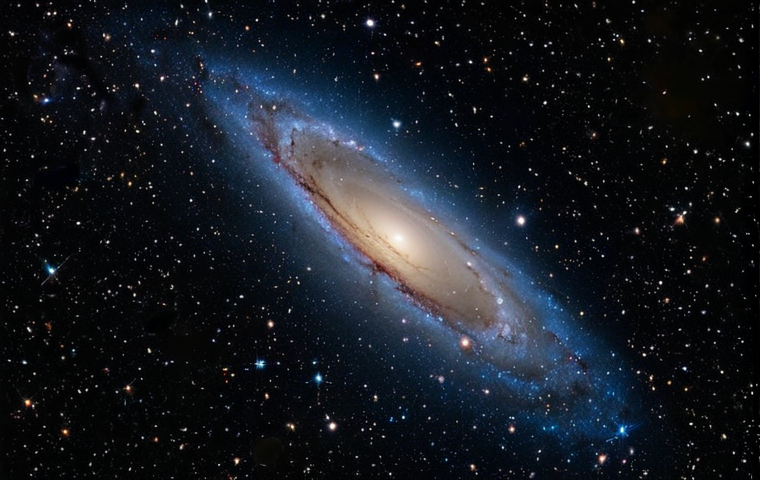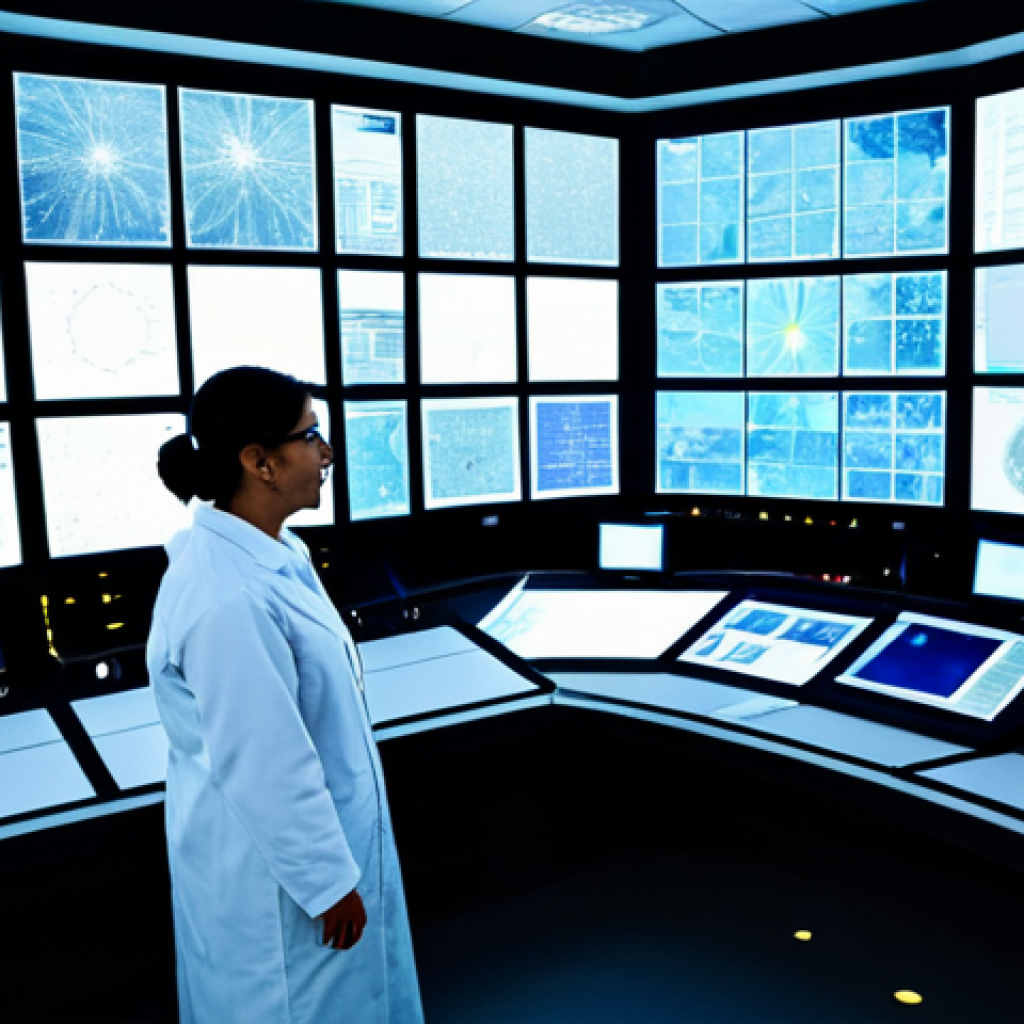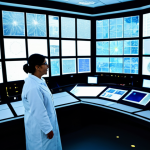Have you ever just gazed up at the night sky and felt that overwhelming sense of wonder, that deep, insatiable curiosity about what’s truly out there?
I certainly have. For me, it was always more than just twinkling lights; it was a cosmic invitation, a profound mystery begging to be unraveled. Astrophysics, coupled with the incredible, ever-evolving eyes of space telescopes, is humanity’s answer to that very invitation.
These aren’t just fancy pieces of glass and metal; they’re literal time machines and alien-world detectors, tirelessly peering back to the universe’s earliest moments and scrutinizing distant exoplanet atmospheres for potential signs of life.
When the James Webb Space Telescope started sending back those breathtaking initial images – galaxies forming just after the Big Bang, or faint chemical fingerprints in an alien world’s air – I remember feeling a genuine, almost physical chill of awe.
It really hit me how close we are to answering humanity’s oldest, most fundamental questions about our place in the cosmos. The future isn’t just about clearer pictures, either; it’s about tackling the massive data streams coming in, where AI and machine learning are becoming indispensable tools to spot patterns we’d otherwise miss.
We’re truly on the cusp of discovering not just Earth-like worlds, but potentially truly habitable environments teeming with possibility. Let’s explore this cosmic frontier together.
The Universe’s Unseen Orchestra: Beyond Human Perception

Have you ever considered how much of the universe is utterly invisible to our naked eyes? It’s a staggering thought, really. For me, that realization was a pivotal moment in understanding just how limited our direct perception truly is.
We see the twinkling stars, the moon, and the occasional planetary visitor, but that’s merely a tiny fraction of the cosmic symphony playing out around us.
This is where space telescopes truly become our indispensable extended senses, revealing a universe that’s far richer, more dynamic, and infinitely more mysterious than we could ever imagine from our Earth-bound vantage point.
They’re not just capturing pretty pictures; they’re decoding the universe’s most profound secrets, from the birth of stars to the violent demise of galaxies, all through the lens of light we can’t see or hear.
When I first learned about how radio telescopes can “listen” to the remnants of the Big Bang, or how X-ray observatories can “see” the extreme energy pouring out of black holes, it felt like unlocking a whole new dimension of reality.
It’s a humbling experience to realize that what we consider “normal” light – the visible spectrum – is but a minuscule sliver of the electromagnetic spectrum.
These telescopes, each tuned to a different cosmic “frequency,” piece together a comprehensive picture of the universe, much like different instruments in an orchestra contribute to a complete musical piece.
Without them, we’d be trying to understand a symphony by only hearing a single note. The engineering marvel behind these instruments, enduring the vacuum of space and the harsh radiation environment, is a testament to human ingenuity and our insatiable drive to understand.
1. Illuminating the Invisible: Multi-Wavelength Astronomy
The true magic of modern astronomy lies in its multi-wavelength approach. It’s like having a set of specialized glasses, each designed to see a specific type of light.
* Radio Waves: These are the longest wavelengths and can pierce through thick cosmic dust clouds, revealing nurseries of nascent stars and mapping the large-scale structure of the universe.
Think about the iconic images from the Event Horizon Telescope, capturing the shadow of a black hole – that’s all done with radio waves! I remember the sheer goosebumps I got when that first image was released; it was direct evidence of something once purely theoretical.
* Infrared Light: This is essentially heat. Infrared telescopes, like the James Webb Space Telescope (JWST), are phenomenal for peering into the dusty, gas-rich regions where stars and planets are forming.
They can also detect the faint, stretched-out light from the very first galaxies, light that has been traveling for billions of years, expanding with the universe into the infrared spectrum.
This “redshift” effect is a direct window into the early cosmos, a true time machine. * Ultraviolet Light: On the other end, UV light reveals hot, energetic phenomena, like massive young stars and active galactic nuclei.
These are processes that emit huge amounts of energy, and seeing them in UV gives us insights into their most energetic phases. * X-rays and Gamma Rays: These are the most energetic forms of light, associated with extreme events like supernova explosions, black hole accretion disks, and neutron star collisions.
Studying these high-energy emissions provides crucial data on the most violent and energetic processes in the cosmos, shedding light on fundamental physics under conditions we can’t replicate on Earth.
2. The Challenge of Distance: Cosmic Time Capsules
Every time we look through a telescope, we’re not just observing space; we’re looking back in time. It’s a concept that always blows my mind a little.
The light from even our nearest star, Proxima Centauri, takes over four years to reach us. When we observe a galaxy billions of light-years away, we’re seeing it as it was billions of years ago.
This isn’t just a quirky byproduct of light speed; it’s a fundamental tool for understanding cosmic evolution. By observing galaxies at different distances, we’re effectively looking at snapshots of the universe at various stages of its development.
It’s like having a family photo album for the entire cosmos. This concept truly brings home the vastness not just of space, but of time itself within the universe.
Exoplanets: Charting the Course to Other Worlds
The hunt for exoplanets – planets orbiting stars other than our Sun – has truly revolutionized our understanding of planetary formation and the potential for life beyond Earth.
When I started following astronomy, exoplanets were a theoretical curiosity, a dream. Now, we’ve confirmed thousands of them, and the sheer diversity we’re finding is absolutely astounding.
From “hot Jupiters” skimming their stars to potentially rocky “super-Earths” in temperate zones, each new discovery adds another piece to the grand puzzle of cosmic habitability.
It makes you feel a profound connection to the universe, realizing that our solar system might just be one of countless similar arrangements. The methods we use to detect these distant worlds are themselves ingenious.
The “transit method,” for example, where a telescope like Kepler or TESS watches for a tiny dip in a star’s brightness as a planet passes in front of it, is like trying to spot a flea walking across a distant flashlight.
Yet, it works, and it has yielded the majority of our known exoplanets. The precision required for such measurements is mind-boggling, a true testament to our technological capabilities.
And it’s not just about detection anymore; we’re now moving into the realm of atmospheric characterization, searching for biosignatures – chemical hints of life – in the atmospheres of these alien worlds.
This is where the excitement really begins to build for me.
1. Identifying Habitable Zones: The Search for Water
The concept of a “habitable zone” – often called the “Goldilocks zone” – is central to our search for life. It’s the region around a star where conditions are just right for liquid water to exist on a planet’s surface.
Not too hot, not too cold, but just right. * Liquid Water as a Prerequisite: On Earth, liquid water is absolutely essential for all known forms of life.
It acts as a solvent, allowing chemical reactions to occur, and plays a crucial role in biological processes. Finding planets within this zone is a primary focus for current missions, as it significantly narrows down the search for potentially life-sustaining environments.
* Atmospheric Characterization: Beyond just being in the right zone, a planet needs an atmosphere to regulate temperature and protect its surface. Future telescopes, like the JWST, are already beginning to analyze the chemical composition of exoplanet atmospheres.
Detecting molecules like water vapor, oxygen, methane, or even specific combinations of gases could provide tantalizing clues about the presence of life.
Imagine the day we get definitive proof of a biosignature; it would fundamentally change humanity’s perspective on our place in the cosmos.
2. Beyond Earth 2.0: Diverse Planetary Systems
While we often search for “Earth 2.0,” the universe is showing us that planetary systems come in an astonishing array of configurations. We’ve found:
* Super-Earths: Planets larger than Earth but smaller than Neptune, some of which may be rocky with thick atmospheres.
* Mini-Neptunes: Gaseous planets smaller than Neptune but larger than Earth. * Rogue Planets: Worlds that wander through interstellar space, unattached to any star.
* Circumbinary Planets: Planets orbiting two stars, like Tatooine in Star Wars, but in real life! This diversity challenges our existing models of planet formation and pushes us to think more broadly about where life might arise.
It’s a wonderful reminder that the universe is far more creative than our imaginations.
The Big Data Universe: AI and Machine Learning’s Role
The amount of data pouring in from space telescopes today is truly staggering. We’re talking terabytes, even petabytes, of information flowing down to Earth every day.
It’s more than any team of human scientists could ever hope to process manually. For me, this is where the power of Artificial Intelligence (AI) and Machine Learning (ML) becomes not just useful, but absolutely essential.
These aren’t just buzzwords; they are the unsung heroes of modern astronomical discovery, sifting through the noise to find the subtle signals that point to new planets, unusual phenomena, or even the faint echoes of the early universe.
When I think about the sheer volume of images coming from surveys like the Vera C. Rubin Observatory, which will map the entire visible sky every few nights, it’s clear that human eyes alone wouldn’t cut it.
AI algorithms can identify transient events – things that suddenly brighten or dim, like supernovae or gravitational lensing events – almost instantaneously.
They can classify millions of galaxies, detect patterns in star clusters, and even help us reconstruct 3D maps of cosmic structures. This collaboration between human ingenuity and artificial intelligence is, to me, the ultimate frontier of scientific exploration, allowing us to ask bigger questions and find answers faster than ever before.
1. Pattern Recognition and Classification
At its core, AI excels at recognizing patterns that might be too subtle or too complex for human eyes to spot across vast datasets. * Exoplanet Detection: ML algorithms are now routinely used to analyze the light curves from stars, identifying the tiny dips caused by transiting planets with higher accuracy and speed than traditional methods.
They can sift through hundreds of thousands of stars, pinpointing potential candidates for further study, saving countless hours of manual review. * Galaxy Classification: Traditionally, astronomers manually classified galaxies based on their shape (spiral, elliptical, irregular).
Now, AI can classify millions of galaxies in a fraction of the time, revealing new insights into galaxy evolution and the cosmic web. This allows researchers to focus on the anomalies, the galaxies that don’t fit the mold, which often lead to new discoveries.
* Identifying Anomalies: One of the most exciting applications is anomaly detection. AI can flag unusual signals or unexpected events that deviate from known patterns, potentially pointing to entirely new classes of celestial objects or phenomena that we haven’t even conceived of yet.
This could be where the next big breakthrough comes from.
2. Data Fusion and Predictive Modeling
AI and ML aren’t just about processing individual datasets; they’re becoming increasingly skilled at combining information from multiple sources and even predicting cosmic behavior.
* Multi-messenger Astronomy: By fusing data from different types of observatories – like optical telescopes, gravitational wave detectors, and neutrino observatories – AI can create a more complete picture of energetic cosmic events, such as the collision of neutron stars.
This “multi-messenger” approach is revolutionizing our understanding of the most violent events in the universe. * Simulations and Predictive Models: AI is also being used to run highly complex simulations of the universe’s evolution, from the formation of large-scale structures to the birth of individual stars.
These models help us test our theories and even predict what we might observe with future telescopes, guiding our research efforts. * Noise Reduction: Space data often comes with a lot of noise.
ML algorithms are incredibly effective at cleaning up this data, separating the signal from the noise, which is crucial for making accurate measurements and discoveries.
This is especially vital for detecting faint signals from the very early universe.
Cosmic Genesis: Tracing the Universe’s First Light
One of the most profound quests in astrophysics is to understand the very beginning of everything – the Big Bang and the universe’s earliest moments. For me, there’s nothing more awe-inspiring than thinking about the cosmic microwave background (CMB), which is essentially the afterglow of the Big Bang, the oldest light we can detect.
It’s like a fossilized baby picture of the universe, offering clues about its initial conditions and subsequent evolution. Every time I see an image of the CMB, it’s a direct connection to that primeval epoch, a truly humbling experience.
Space telescopes, particularly those operating in the microwave and infrared parts of the spectrum, are absolutely critical for this endeavor. They allow us to peer back to an era when the universe was just a few hundred thousand years old, long before the first stars and galaxies had even formed.
By studying the tiny temperature fluctuations in the CMB, scientists can infer details about the universe’s geometry, its composition, and how structure began to emerge from what was once an almost perfectly uniform soup of particles.
It’s truly a journey back to the dawn of time, and the revelations continue to challenge our understanding of fundamental physics.
1. The Cosmic Microwave Background: Echoes of the Big Bang
The CMB is a faint glow of radiation that fills the universe, a relic from about 380,000 years after the Big Bang, when the universe cooled enough for atoms to form and light to travel freely.
* Planck and WMAP Missions: Missions like NASA’s WMAP (Wilkinson Microwave Anisotropy Probe) and ESA’s Planck satellite have mapped the CMB with unprecedented precision.
These maps reveal tiny temperature variations – literally ripples in the fabric of spacetime – that are the seeds from which all the large-scale structures in the universe (galaxies, clusters of galaxies) eventually grew.
The data from these missions has been instrumental in confirming the Big Bang theory and refining our cosmological model. * Inflation Theory: The smoothness of the CMB, coupled with these tiny fluctuations, provides strong evidence for the theory of cosmic inflation, a period of extremely rapid expansion just a fraction of a second after the Big Bang.
This theory helps explain why the universe is so remarkably uniform on large scales while also containing the necessary initial irregularities for structure formation.
It’s a mind-bending concept that solves several puzzles about the early universe.
2. First Light and Reionization: The Universe’s Dark Ages
After the CMB, the universe entered a period known as the “Cosmic Dark Ages,” where there were no stars or galaxies to produce light. This period lasted for hundreds of millions of years.
* The Dawn of Stars and Galaxies: The James Webb Space Telescope (JWST) is uniquely designed to pierce through this epoch. Its infrared capabilities allow it to detect the extremely redshifted light from the very first stars and galaxies, which ended the Dark Ages by “reionizing” the neutral hydrogen that pervaded the early universe.
Seeing these earliest cosmic beacons is like finding the first flickering candles in a vast, dark room. I get chills just thinking about the pioneering observations it’s already made.
* Understanding Reionization: The reionization process is crucial for understanding how the universe evolved from a uniform state to the complex structure we see today.
By identifying and studying these first luminous objects, we gain insights into the conditions that led to the formation of everything we know. This is where truly new and unexpected physics might be waiting.
Cosmic Collisions and Galactic Evolution: A Universe in Motion
The universe is far from static. It’s a dynamic, evolving tapestry of interactions, with galaxies colliding, stars being born and dying, and black holes growing to unimaginable sizes.
For me, observing these grand cosmic dramas, albeit in slow motion from our perspective, underscores the sheer power and ongoing evolution of the cosmos.
It’s not just a collection of static objects; it’s a living, breathing entity undergoing constant transformation. Understanding these processes is key to piecing together the full narrative of cosmic evolution.
Space telescopes are our primary tools for witnessing these events. From the stunning images of colliding galaxies captured by Hubble, showcasing the intricate dance of gravitational forces, to the detection of gravitational waves from merging black holes by ground-based observatories, we are literally seeing the universe shape itself.
It makes you realize that our own Milky Way galaxy is part of this grand cosmic ballet, destined to eventually merge with our neighbor, Andromeda, billions of years from now.
This constant state of change and interaction is a fundamental aspect of the universe’s story.
1. Galactic Mergers: The Dance of Giants
Galaxies are not isolated islands; they interact and collide, often leading to spectacular transformations and bursts of star formation. * Formation of Elliptical Galaxies: Many of the large elliptical galaxies we observe are thought to be the result of multiple galactic mergers over cosmic time.
These collisions strip gas and dust from galaxies, redistribute stars, and can trigger intense bursts of star formation, followed by a period of quiescence.
* Supermassive Black Hole Growth: Galactic mergers play a crucial role in the growth of supermassive black holes at the centers of galaxies. When galaxies merge, their central black holes can also merge, leading to incredibly powerful gravitational wave events and intense bursts of radiation.
The study of these mergers helps us understand the co-evolution of galaxies and their central black holes. * Starburst Galaxies: Sometimes, the shockwaves from a galactic collision can compress gas clouds, triggering a massive burst of star formation – creating what are known as “starburst galaxies.” These are incredibly luminous and provide insights into how galaxies rapidly build up their stellar populations.
2. The Lifecycle of Stars: From Dust to Giants
Stars are the fundamental building blocks of galaxies, and understanding their birth, life, and death cycles is essential for comprehending the universe’s composition.
* Stellar Nurseries: Space telescopes like Hubble and JWST have provided breathtaking images of stellar nurseries – vast clouds of gas and dust where new stars are born.
These observations reveal the intricate processes of gravitational collapse and accretion that lead to the ignition of a star. * Supernovae and Neutron Stars: The dramatic end-of-life events for massive stars, supernovae, are not just beautiful cosmic explosions; they are also the primary cosmic factories for heavier elements, including those essential for life.
The remnants of these explosions can be neutron stars or even black holes, objects of extreme density and gravity that continue to influence their surroundings.
* Element Forges: Every atom heavier than hydrogen and helium, from the oxygen we breathe to the iron in our blood, was forged inside stars and dispersed into the universe through supernova explosions.
This cosmic recycling means that we are, quite literally, made of stardust. This thought, for me, is perhaps the most profound connection we have to the cosmos.
The Next Frontier: Pushing Observational Boundaries
While we’ve made incredible strides in our understanding of the universe, the journey is far from over. In fact, for me, it feels like we’re just scratching the surface.
The next generation of space observatories promises to push the boundaries of what’s possible, peering deeper into the cosmos, detecting fainter signals, and asking even bolder questions.
These aren’t just incremental upgrades; they represent quantum leaps in our observational capabilities, promising to revolutionize our understanding of everything from dark energy to the fundamental laws of physics.
The ambition behind these projects is truly inspiring. They involve international collaborations, cutting-edge technology, and a shared human desire to unveil the unknown.
As someone who has watched this field evolve, it’s clear that the future of astrophysics lies not just in bigger mirrors or more sensitive detectors, but in entirely new ways of observing and interpreting the universe.
The prospect of what we might discover in the coming decades is genuinely exhilarating; it feels like we are living in a golden age of cosmic exploration.
1. Future Space Telescopes: Beyond JWST
While the James Webb Space Telescope is currently making headlines, plans are already well underway for its successors, each designed to tackle specific, profound questions.
* Nancy Grace Roman Space Telescope: Set to launch in the mid-2020s, Roman (formerly WFIRST) will have a wide field of view, making it ideal for studying dark energy, exoplanets through microlensing, and large-scale galaxy surveys.
Its expansive vision will complement JWST’s detailed focus. * Habitable Worlds Observatory (HWO): This proposed mission, currently in conceptual stages, is envisioned as the ultimate exoplanet hunter.
Its primary goal would be to directly image Earth-like exoplanets and characterize their atmospheres, searching specifically for biosignatures. This would be a game-changer in the search for extraterrestrial life.
* LUVOIR (Large Ultraviolet Optical Infrared Surveyor): Another concept, LUVOIR, would be a massive general-purpose observatory, much larger than Hubble, capable of performing a vast array of astrophysical observations, from studying distant galaxies to characterizing exoplanet atmospheres.
It represents the pinnacle of multi-wavelength observation from space.
| Space Telescope | Primary Wavelength(s) | Key Scientific Focus Areas | Notable Discoveries/Contributions (My Take) |
|---|---|---|---|
| Hubble Space Telescope (HST) | Visible, UV, Near-Infrared | Galactic evolution, stellar lifecycles, dark energy (Hubble constant), exoplanet atmospheres. | Its deep field images changed my perspective on the sheer number of galaxies. Truly iconic! |
| Chandra X-ray Observatory | X-ray | Black holes, supernovae remnants, galaxy clusters, high-energy phenomena. | Revealed the violent nature of cosmic events, showing a universe far more energetic than I’d imagined. |
| Spitzer Space Telescope | Infrared | Exoplanets, star/planet formation, distant galaxies, cosmic dust. | A pioneer in infrared, it opened my eyes to dusty nurseries where new stars quietly emerge. |
| James Webb Space Telescope (JWST) | Infrared (Near-Mid) | First galaxies, exoplanet atmospheres, star/planet formation, early universe. | Absolutely breathtaking images! It feels like a time machine, showing us the universe’s infancy. |
2. The Search for Life’s Origins: Astrochemistry and Astrobiology
Beyond just finding planets, the next frontier involves understanding the fundamental building blocks of life in space and how they might have come together.
* Cosmic Chemistry: Astrochemical research, often aided by space telescopes, investigates the complex molecules that exist in interstellar space and in protoplanetary disks.
Many of these molecules are organic – carbon-based – and are the precursors to life as we know it. Discovering these precursors in vast quantities throughout the galaxy suggests that the ingredients for life are ubiquitous.
* Enceladus and Europa: Looking closer to home, missions to icy moons like Saturn’s Enceladus and Jupiter’s Europa, which are believed to harbor subsurface oceans of liquid water, are key.
While not technically “space telescopes,” future probes to these moons will act as specialized observatories, directly sampling plumes of water ejected into space or even drilling through ice to search for signs of microbial life.
The thought of finding life just within our own solar system is, for me, incredibly exciting. It would be a monumental shift in our understanding of life’s place in the universe.
* Technosignatures: Beyond biosignatures, some research is beginning to explore the search for “technosignatures” – evidence of advanced technology from other civilizations.
This is still highly speculative, but the possibility that highly advanced telescopes could detect artificial light sources or atmospheric pollution on exoplanets, albeit far in the future, is an intriguing avenue of exploration.
The Human Element: Passion, Collaboration, and the Future of Cosmic Discovery
At the heart of every groundbreaking discovery, every stunning image, and every complex data analysis in astrophysics is the human spirit. It’s the relentless curiosity of scientists, the ingenuity of engineers, and the passionate collaboration across borders that truly drives our understanding of the cosmos forward.
I’ve always found it incredibly inspiring how diverse teams, often from different countries and cultures, come together to design, build, launch, and operate these incredibly complex machines that push the very limits of human knowledge.
It’s a testament to what we can achieve when we work together towards a common, profound goal. When I hear an astronomer talk about the moment they first saw a new galaxy forming or detected a unique signal from a distant exoplanet, you can feel their unbridled excitement, their genuine wonder.
That shared sense of awe, that collective drive to unravel the universe’s secrets, is what makes this field so vibrant and endlessly fascinating. It’s a pursuit that transcends national boundaries and speaks to a universal human desire to understand our place in the grand scheme of things.
This deep, almost spiritual connection to the cosmos is, for me, the true essence of astrophysics.
1. International Collaboration: A Global Endeavor
Building and operating cutting-edge space observatories requires resources, expertise, and a level of collaboration that transcends individual nations.
* ESA, NASA, JAXA Partnerships: Major space agencies like NASA, the European Space Agency (ESA), and the Japan Aerospace Exploration Agency (JAXA) frequently collaborate on large missions, sharing costs, expertise, and scientific returns.
The James Webb Space Telescope, for instance, is a prime example of a successful international partnership, bringing together the best minds from different continents.
This kind of global cooperation is a powerful model for tackling other grand challenges facing humanity. * Scientific Openness: The data collected by these telescopes is often made publicly available to the global scientific community.
This openness fosters rapid discovery, allowing researchers worldwide to analyze the same data, cross-reference findings, and build upon each other’s work, accelerating the pace of scientific progress.
It’s a wonderful example of science at its most collaborative and democratic.
2. Inspiring the Next Generation: A Legacy of Wonder
The stunning images and profound discoveries from space telescopes don’t just inform scientists; they inspire millions of people around the world, particularly young minds.
* Public Engagement: Websites, documentaries, social media, and citizen science projects bring the wonders of the universe directly into homes and classrooms.
I’ve personally seen the spark in a child’s eyes when they see a picture of a nebula for the first time, or learn about a planet orbiting a distant star.
That spark of curiosity is essential for fostering future generations of scientists, engineers, and critical thinkers. * Citizen Science Initiatives: Platforms like Zooniverse allow ordinary citizens to contribute to real scientific research by classifying galaxies, searching for exoplanets, or analyzing data.
This democratizes science and allows anyone with an internet connection to become a part of cosmic discovery, fostering a deeper connection between the public and scientific endeavors.
It truly makes astronomy a participatory adventure. * Beyond the Numbers: While the scientific data is crucial, the cultural impact of space exploration is immense.
It challenges our perspectives, pushes the boundaries of our imagination, and reminds us of the vast potential of human ingenuity. It’s a journey that speaks to the deepest parts of our human nature, a timeless quest that will continue for generations to come.
Closing Thoughts
As I reflect on the incredible journey of cosmic discovery, it’s clear that our insatiable curiosity about the universe is a defining characteristic of humanity.
From the earliest stargazers to the engineers crafting the next generation of space telescopes, we are constantly pushing the boundaries of what’s possible, driven by a profound desire to understand our place in this vast, mysterious cosmos.
Every new image, every detected signal, every piece of data brings us closer to unraveling the universe’s most ancient secrets and discovering what lies beyond.
This ongoing exploration is not just about scientific progress; it’s a testament to our shared spirit of wonder and an enduring quest that binds us all.
The universe truly is an unseen orchestra, and we are privileged to be slowly, meticulously, learning to hear its full, magnificent symphony.
Helpful Information to Know
1. Explore Reputable Sources: For ongoing discoveries and stunning imagery, regularly visit the official websites of major space agencies like NASA (nasa.gov), ESA (esa.int), and JAXA (global.jaxa.jp). They offer press releases, educational content, and high-resolution images that are truly captivating.
2. Engage with Citizen Science: Websites like Zooniverse (zooniverse.org) offer incredible opportunities for anyone to contribute to real astronomical research. You can help classify galaxies, search for exoplanets, or identify cosmic events, making a tangible difference in scientific discovery from your own home.
3. Join Local Astronomy Clubs: If you’re passionate about the night sky, consider finding a local astronomy club. They often host stargazing events, provide access to powerful telescopes, and offer a community of like-minded enthusiasts who can share their knowledge and passion with you.
4. Consider Online Courses: Many universities and platforms like Coursera or edX offer free or affordable online courses on astronomy, astrophysics, and cosmology. These can be an excellent way to deepen your understanding of the concepts discussed here and explore new areas of cosmic science.
5. Attend Planetarium Shows: Visiting a local planetarium can provide an immersive and educational experience, bringing the wonders of the universe to life in a way that static images cannot. They often update their shows with the latest discoveries, offering a dynamic view of cosmic evolution.
Key Takeaways
Space telescopes extend our senses beyond visible light, revealing the universe’s multi-wavelength symphony. They act as cosmic time machines, allowing us to observe the universe’s past.
The hunt for exoplanets is redefining our understanding of cosmic habitability, with the James Webb Space Telescope leading the search for biosignatures.
Artificial Intelligence is indispensable for processing vast astronomical data, accelerating discovery in pattern recognition and predictive modeling.
We are actively tracing the universe’s first light via the Cosmic Microwave Background and observing the “reionization” epoch. Finally, understanding galactic evolution and stellar lifecycles highlights the dynamic, ever-changing nature of the cosmos.
The future promises even grander observatories and the collaborative human spirit continues to drive our quest to unravel the universe’s deepest mysteries.
Frequently Asked Questions (FAQ) 📖
Q: What exactly makes these new-generation space telescopes, like the James Webb, so much more powerful than their predecessors?
A: Oh, it’s not just a step up; it’s like going from a blurry black-and-white TV to a massive 8K IMAX screen. The biggest game-changer is the infrared capability.
Hubble mostly saw in visible light, but JWST is designed to see in infrared, which is absolutely crucial because the universe is expanding. That expansion stretches light from incredibly distant, ancient objects into longer, redder wavelengths.
So, by seeing in infrared, JWST can literally peer further back in time, almost to the very earliest moments after the Big Bang itself. When those first images started pouring in – the Carina Nebula, Stephen’s Quintet – it was genuinely mind-boggling.
I remember feeling this profound sense of awe, thinking, “We’re actually seeing things as they were before our own solar system even existed.” It’s like having cosmic X-ray vision, piercing through the thick cosmic dust clouds that used to obscure everything we wanted to see.
Q: You mentioned the “massive data streams” and the role of
A: I. How is that really changing the game for astrophysicists working with this new data? A2: Honestly, without AI now, we’d be completely drowning.
Imagine trying to sift through terabytes, even petabytes, of data coming in every single day – it’s just humanly impossible. What used to take teams of researchers months, or even years, meticulously cross-referencing spectral lines or identifying faint exoplanet transits, AI can do in minutes.
But it’s not just about speed. AI algorithms can spot incredibly subtle patterns or anomalies that our human brains, with all their inherent biases and limitations, would simply miss.
I’ve seen firsthand how an AI model can pick out a weird, unexplainable dip in a star’s light curve that later turns out to be a potential sign of an unknown planetary system.
It feels less like replacing us and more like giving us superpowers, freeing us up for the truly creative, hypothesis-driven work that AI isn’t quite ready for yet.
It’s like having an army of tireless, unbiased assistants.
Q: Given all this incredible progress, what’s your personal biggest hope or dream for what we might discover in the next decade or two?
A: My personal dream, the thing that genuinely keeps me up at night in the best possible way, is finding definitive, undeniable evidence of biosignatures – chemical signs of life – in an exoplanet’s atmosphere.
We’re already getting incredibly good at sniffing out things like water vapor, methane, and carbon dioxide in distant worlds. But to find something undeniably linked to biological processes, perhaps a truly unusual combination of gases that simply couldn’t form without life?
That would be it. I’m not talking about little green men necessarily, but even definitive proof of microbial life elsewhere would fundamentally change everything we understand about our place in the universe.
Imagine looking up at the stars and knowing, with absolute certainty, that we are not alone. That’s the ultimate cosmic lottery ticket, and with the upcoming observatories on the horizon, it feels closer than ever before.
It’s an almost spiritual hope, really.
📚 References
Wikipedia Encyclopedia
구글 검색 결과
구글 검색 결과
구글 검색 결과
구글 검색 결과
구글 검색 결과





